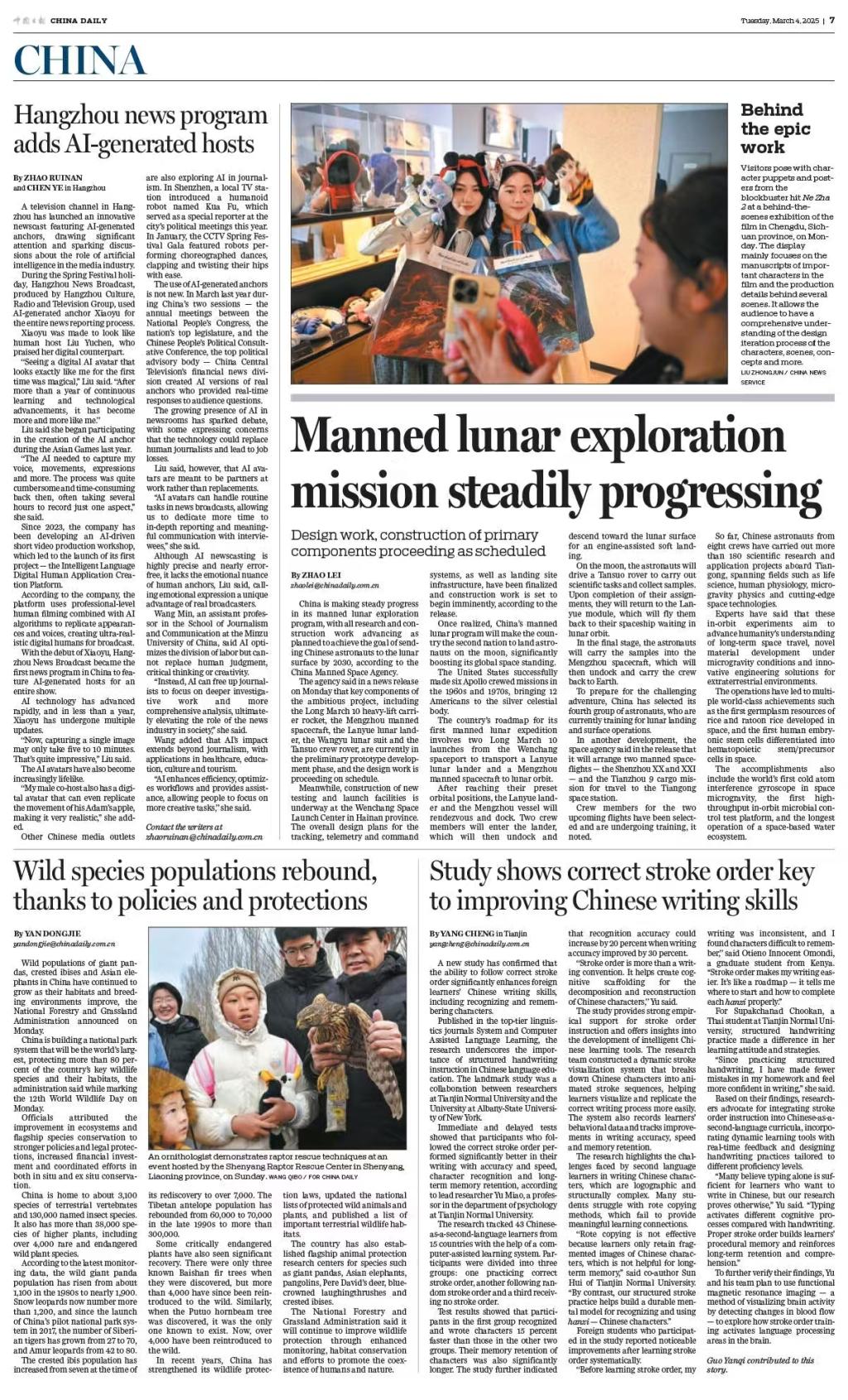

By Guo Yanqi in Beijing and Yang Cheng in Tianjin
A new study has confirmed that stroke order significantly enhances foreign learners’ ability to write, recognize and retain Chinese characters.
Published in the top-tier linguistics journals System and Computer Assisted Language Learning, the research proved the essence of structured handwriting instruction in Chinese language education.
The landmark study was a collaboration between researchers at Tianjin Normal University and the University at Albany, State University of New York.
The research revealed that immediate and delayed tests showed that participants who followed the correct stroke order performed significantly better in Chinese characters writing accuracy, speed, recognition, and long-term retention, according to Yu Miao, lead researcher of the research and a professor of the Department of Psychology at TNU.
The study also indicated that recognition accuracy increased by 20 percent, while writing accuracy improved by 30 percent. Participants using correct stroke order also recognized and wrote 15 percent faster and retained characters significantly longer compared to those with random or no stroke order.
“Stroke order is more than a writing convention—it helps to create cognitive scaffolding for the decomposition and reconstruction of Chinese characters,” explained Yu Miao, lead researcher of the research and a professor of the Department of Psychology at TNU.
The study provides strong empirical support for stroke order instruction and offers insights into the development of intelligent Chinese learning tools.
The research tracked 43 Chinese-as-a-second-language learners from 15 countries using a proprietary computer-assisted learning system.
Participants were divided into three conditions: one practicing correct stroke order, another following random stroke order, and a third receiving no stroke order.
The team’s dynamic stroke visualization system, which breaks down Chinese characters into animated stroke sequences, allows learners to visualize and replicate the correct writing process.
It also records behavioral data, tracking improved writing accuracy, speed, and memory retention.
The research highlights the challenges CSL learners face when writing Chinese characters, which are logographic and structurally complex.
Many students struggle with rote copying methods, which fail to provide meaningful learning connections.
“Rote copying leads to fragmented Chinese characters representations and weakens long-term retention,” explained co-author Sun Hui at TNU.
"By contrast, structured stroke practice builds durable mental schemata for Hanzi production and recognition,” Sun said.
Foreign students who participated in the study reported noticeable improvements after learning stroke order systematically.
“Before learning stroke order, my writing was inconsistent and difficult to remember,” said Otieno Innocent Omondi, a student from Kenya, a graduate from TNU.
“Stroke order makes my writing easier. It’s like a roadmap—it tells me where to start and how to complete each Hanzi properly,” Omondi said.
For Supakchanad Chookan, a Thai student at TNU, structured handwriting practice made a difference in learning attitude and strategies.
“Since practicing structured handwriting, I have made fewer mistakes in my homework and felt more confident in writing. It has become a habit that further supports my learning.”
Based on these findings, researchers advocate for integrating stroke order instruction into CSL curricula, incorporating dynamic learning tools with real-time feedback, and designing handwriting practices tailored to different proficiency levels.
“Many believe typing alone is sufficient for learning Chinese, but our research proves otherwise,” Yu said.
“Typing activates different cognitive processes than handwriting. Proper stroke order builds procedural memory, reinforcing long-term retention and comprehension.”
To further verify the findings, Yu and his team plan to use functional magnetic resonance imaging, a way to visualize brain activity by detecting changes in blood flow to explore how stroke order training activates language processing areas in the brain.
Moving forward, the research team aims to combine handwriting practices with digital learning science to optimize Chinese character learning.
They also plan to expand their study by conducting a longitudinal study involving more CSL learners in parallel groups to measure how structured writing practice influences long-term learning.
一項新研究證實,筆順顯著提高了外國學習者書寫、識別和記憶漢字的能力。這項研究發表在國際頂尖語言學期刊《系統》和《計算機輔助語言學習》上,證明了結構化手寫教學在漢語教育中的重要性。
這兩項研究由天津師范大學和美國紐約州立大學奧爾巴尼分校的研究人員合作完成。該研究負責人,天津師范大學心理學部于秒教授表示,即時和延遲測試均表明,學習了正確筆順后,參與者在漢字書寫的準確性、速度、識別和長期記憶方面表現明顯更好。
具體來說,與學習隨機筆順或無筆順相比,參與者學習正確筆順后,其識別準確率提高了20%,書寫準確率提高了30%;識別和書寫速度也提高了15%,并且記憶漢字的時間明顯更長。
對于結果,于秒解釋道:“筆順不僅僅是一種書寫規范,它也有助于為漢字的分解和重構創造認知框架。”這項研究為筆順教學提供了強有力的實證支持,并為開發智能漢語學習工具提供了見解。
研究使用自主設計的計算機輔助筆順學習系統,跟蹤了來自15個國家的43名漢語作為第二語言的學習者。參與者被分為三種條件:一種練習正確的筆順,另一種遵循隨機筆順,第三種不遵循筆順。該團隊的動態筆順可視化系統將漢字分解為動畫筆順序列,使學習者能夠可視化和復制正確的書寫過程。
研究強調了外國學習者在書寫漢字時面臨的挑戰。漢字作為表意文字,結構復雜,許多學生都在死記硬背的抄寫方法中苦苦掙扎,這種方法無法提供有意義的學習聯系。
兩項研究的主要作者、天津師范大學博士生孫會解釋說:“死記硬背的抄寫會導致漢字的碎片化記憶,從而削弱長期記憶。相比之下,結構化的筆順練習為漢字的產生和識別建立了持久的心理圖式。”
參與研究的外國學生表示,在系統地學習筆順后,他們的漢字書寫有了明顯的進步。天津師范大學畢業生,來自肯尼亞的Otieno Innocent Omondi說:“在學習筆順之前,我的書寫不一致且難以記住。筆順使我的書寫更容易。它就像一張路線圖——告訴我從哪里開始以及如何正確地完成每個漢字。”
對于天津師范大學的泰國學生Supakchanad Chookan來說,結構化的手寫練習改變了她的學習態度和策略。“練習筆順后,我在作業中犯的錯誤更少,書寫時也更有信心。這已經成為一種習慣,進一步支持了我的學習。”
基于這些發現,研究人員主張將筆順教學納入漢語課程,結合具有實時反饋的動態學習工具,并設計適合不同水平學習者的手寫練習。
于秒表示:“許多人認為僅靠打字就足以學習漢語,但我們的研究證明并非如此。打字激活的認知過程與手寫不同。正確的筆順有助于建立程序性記憶,增強長期記憶和理解。”
為了進一步驗證這些發現,于秒和他的團隊計劃使用功能性磁共振成像(一種通過檢測血流變化來可視化大腦活動的方法)來探索筆順訓練如何激活大腦中的語言加工區域。
接下來,研究團隊的目標是將手寫練習與數字學習科學相結合,以優化漢字學習。他們還計劃通過開展涉及更多外國學習者的縱向研究,以衡量結構化書寫練習如何影響長期學習效果。
來源:2025年3月4日 CHINA DAILY 第7版
鏈接:http://epaper.chinadaily.com.cn/a/202503/04/WS67c6305fa310f4a5fb061ecb.html